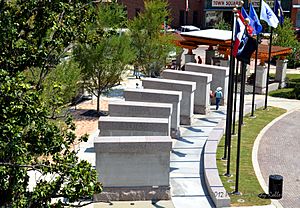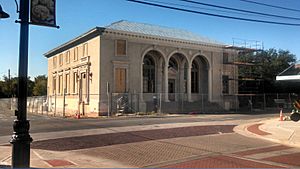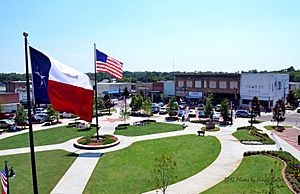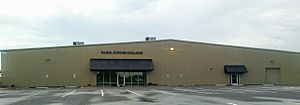Sulphur Springs, Texas facts for kids
Quick facts for kids
Sulphur Springs, Texas
|
|
|---|---|
| City of Sulphur Springs | |
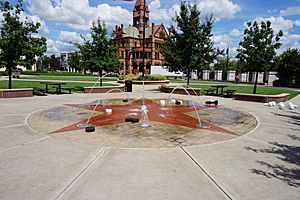
Sulphur Springs in 2015
|
|
| Motto(s):
“Just Play. Have Fun. Celebrate!”
|
|
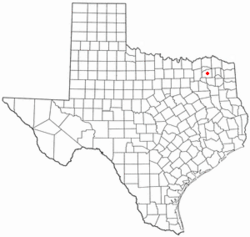
Location of Sulphur Springs, Texas
|
|
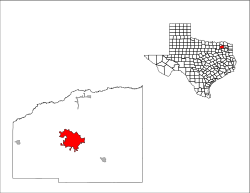 |
|
| Country | United States |
| State | Texas |
| County | Hopkins |
| Government | |
| • Type | Council-manager |
| Area | |
| • Total | 23.91 sq mi (61.94 km2) |
| • Land | 20.54 sq mi (53.20 km2) |
| • Water | 3.38 sq mi (8.74 km2) |
| Elevation | 502 ft (153 m) |
| Population
(2020)
|
|
| • Total | 15,941 |
| • Density | 776/sq mi (300/km2) |
| Time zone | UTC-6 (Central (CST)) |
| • Summer (DST) | UTC-5 (CDT) |
| ZIP codes |
75482-75483
|
| Area code(s) | 903 |
| FIPS code | 48-70904 |
| GNIS feature ID | 1348056 |
Sulphur Springs is a city in Texas, USA. It's the main city of Hopkins County. In 2020, about 15,941 people lived there. You can find Sulphur Springs in Northeast Texas.
Contents
History of Sulphur Springs
Sulphur Springs got its name because when people first settled here, there were many natural springs with sulfur in the water.
Early Settlement and Growth
One of the first settlers was Eli Bib. He ran a store from his cabin. He sold everyday items and drinks. In 1849, Dr. and Mrs. Davis moved to the area. Dr. Davis thought this spot would become a great city.
In 1850, the first church was started by the Methodist Episcopal group. It was finished in 1853. The Presbyterian Church was formed in 1852. At that time, about 441 people lived in the village. New stores opened to serve the growing number of people.
Becoming a City
The village became a city in 1854 when the first post office opened. The city's first name was "Bright Star." Mail was delivered by the Pony Express. On May 18, 1871, the state government moved the county seat (the main city for county business) of Hopkins County to Sulphur Springs. The name "Bright Star" was then removed from the postal records.
Local government started slowly. William A. Wortham was the first known mayor. In 1854, he bought a printing press and moved to Sulphur Springs. He and his brother-in-law started the city's first newspaper.
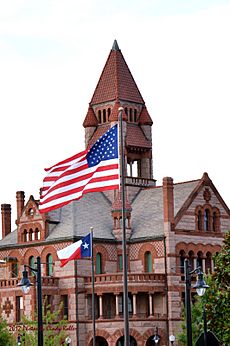
Newspapers and Education
Sulphur Springs had many newspapers over the years. The Echo Publishing Company started in 1897. It was the first printing company in the city to use steam power. Later, it used gasoline as fuel.
In 1857, the city set aside land for Bright Star University. Sulphur Springs District Conference High School began in 1877 on this land. In 1882, it became Central College, owned by the Methodist Episcopal Church. It was later called Eastman College. The college eventually burned down.
The First National Bank of Sulphur Springs opened in 1855. Today, it is known as City National Bank.
City Development and Railroads
In 1857, the first steam-powered factory was built. The Morro Castle building was also built that year.
C. Denton was chosen to lead the new city government. The city had lost its official status during the Civil War. It had to be officially recognized again by the state government.
In 1868, federal troops came to Sulphur Springs. They stayed for two years after the Civil War to help protect newly freed people. After they left, A. J. Bridges became mayor.
The building of a railroad line in 1872 helped the city grow. People heard stories about the healing power of the sulfur baths. As more people moved in, the sulfur springs were covered up. None are active today. More rail lines were built, connecting Sulphur Springs to other cities like Fort Worth by 1888.
An ice plant was built in 1887. The city's courthouse, still used today, was built in 1895. In 1904, wells were dug to provide water for the city. A long-distance telephone line also connected Sulphur Springs to nearby Greenville that year.
Modern Era
After World War II, the city changed its government style to a council-manager system. This led to new programs and industries. New factories came to the city, and the population grew.
The dairy industry was very important to the local economy from the late 1940s until 1995. The Southwest Dairy Museum in the city shows the history of milk production. The dairy industry started to shrink because milk prices dropped and costs went up.
Today, large companies in the area include Pinnacle, Ocean Spray, Grocery Supply, and Flowserve. In 2012, Hopkins County had a very low unemployment rate, and many new jobs were created.
Geography of Sulphur Springs
Sulphur Springs is in the middle of Hopkins County. It's about halfway between Dallas and Texarkana. Interstate 30 runs through the south side of the city. This highway connects Sulphur Springs to Mount Pleasant and Texarkana to the east, and to Greenville and Dallas to the west.
Other major roads like Texas State Highway 19, Texas State Highway 11, and Texas State Highway 154 also pass through the city.
The city covers about 61.9 square kilometers (23.9 square miles). Most of this is land, but about 14.1% is water. The city is part of the Rock Creek watershed, which flows into the Sulphur River.
Climate and Weather
| Climate data for Sulphur Springs, Texas (1991–2020 normals, extremes 1893–1910, 1945–present) | |||||||||||||
|---|---|---|---|---|---|---|---|---|---|---|---|---|---|
| Month | Jan | Feb | Mar | Apr | May | Jun | Jul | Aug | Sep | Oct | Nov | Dec | Year |
| Record high °F (°C) | 83 (28) |
91 (33) |
91 (33) |
96 (36) |
101 (38) |
107 (42) |
111 (44) |
115 (46) |
112 (44) |
101 (38) |
89 (32) |
85 (29) |
115 (46) |
| Mean maximum °F (°C) | 74.5 (23.6) |
77.9 (25.5) |
83.1 (28.4) |
86.4 (30.2) |
91.6 (33.1) |
96.4 (35.8) |
101.5 (38.6) |
102.5 (39.2) |
98.4 (36.9) |
91.0 (32.8) |
82.0 (27.8) |
75.8 (24.3) |
103.9 (39.9) |
| Mean daily maximum °F (°C) | 55.2 (12.9) |
59.5 (15.3) |
67.0 (19.4) |
74.9 (23.8) |
82.4 (28.0) |
89.9 (32.2) |
94.2 (34.6) |
94.9 (34.9) |
88.9 (31.6) |
78.2 (25.7) |
66.3 (19.1) |
57.3 (14.1) |
75.7 (24.3) |
| Daily mean °F (°C) | 44.6 (7.0) |
48.7 (9.3) |
56.1 (13.4) |
63.7 (17.6) |
72.3 (22.4) |
80.2 (26.8) |
84.1 (28.9) |
84.0 (28.9) |
77.4 (25.2) |
66.3 (19.1) |
55.2 (12.9) |
46.7 (8.2) |
64.9 (18.3) |
| Mean daily minimum °F (°C) | 34.0 (1.1) |
37.8 (3.2) |
45.2 (7.3) |
52.4 (11.3) |
62.2 (16.8) |
70.5 (21.4) |
73.9 (23.3) |
73.1 (22.8) |
65.8 (18.8) |
54.3 (12.4) |
44.1 (6.7) |
36.1 (2.3) |
54.1 (12.3) |
| Mean minimum °F (°C) | 17.9 (−7.8) |
22.1 (−5.5) |
26.4 (−3.1) |
36.0 (2.2) |
45.9 (7.7) |
58.8 (14.9) |
65.2 (18.4) |
63.4 (17.4) |
49.9 (9.9) |
37.0 (2.8) |
26.2 (−3.2) |
20.5 (−6.4) |
14.8 (−9.6) |
| Record low °F (°C) | 0 (−18) |
−4 (−20) |
11 (−12) |
27 (−3) |
36 (2) |
48 (9) |
53 (12) |
49 (9) |
39 (4) |
23 (−5) |
14 (−10) |
−4 (−20) |
−4 (−20) |
| Average precipitation inches (mm) | 3.30 (84) |
3.63 (92) |
4.43 (113) |
4.31 (109) |
4.30 (109) |
4.27 (108) |
3.03 (77) |
2.92 (74) |
2.96 (75) |
4.90 (124) |
3.98 (101) |
4.47 (114) |
46.50 (1,181) |
| Average precipitation days (≥ 0.01 in) | 10.4 | 10.4 | 10.4 | 9.3 | 10.4 | 8.0 | 6.1 | 6.0 | 6.4 | 7.9 | 9.2 | 10.8 | 105.3 |
| Source: NOAA | |||||||||||||
People of Sulphur Springs
| Historical population | |||
|---|---|---|---|
| Census | Pop. | %± | |
| 1860 | 621 | — | |
| 1870 | 921 | 48.3% | |
| 1880 | 1,854 | 101.3% | |
| 1890 | 3,038 | 63.9% | |
| 1900 | 3,635 | 19.7% | |
| 1910 | 5,151 | 41.7% | |
| 1920 | 5,558 | 7.9% | |
| 1930 | 5,417 | −2.5% | |
| 1940 | 6,742 | 24.5% | |
| 1950 | 8,991 | 33.4% | |
| 1960 | 9,160 | 1.9% | |
| 1970 | 10,642 | 16.2% | |
| 1980 | 12,804 | 20.3% | |
| 1990 | 14,062 | 9.8% | |
| 2000 | 14,551 | 3.5% | |
| 2010 | 15,449 | 6.2% | |
| 2020 | 15,941 | 3.2% | |
| 2023 (est.) | 16,262 | 5.3% | |
| U.S. Decennial Census | |||
| Race | Number | Percentage |
|---|---|---|
| White (NH) | 10,008 | 62.78% |
| Black or African American (NH) | 1,906 | 11.96% |
| Native American or Alaska Native (NH) | 83 | 0.52% |
| Asian (NH) | 155 | 0.97% |
| Pacific Islander (NH) | 4 | 0.03% |
| Some Other Race (NH) | 39 | 0.24% |
| Mixed/Multi-Racial (NH) | 648 | 4.06% |
| Hispanic or Latino | 3,098 | 19.43% |
| ’’’Total’’’ | ’’’15,941’’’ |
In 2020, about 15,941 people lived in Sulphur Springs. There were 6,054 households and 3,906 families. In 2010, the city had 15,449 people.
About 30% of households had children under 18. Many households (46.1%) were married couples. About 28.4% of households were people living alone. The average household had 2.53 people.
The median age in the city was 36.2 years. This means half the people were older than 36.2 and half were younger.
Economy and Jobs
Sulphur Springs has a strong economy with several major employers.
Top Employers in Sulphur Springs
| Number | Employer | Employees |
|---|---|---|
| 1 | Sulphur Springs Independent School District | 634 |
| 2 | Grocery Supply Company | 450 |
| 3 | Walmart | 400 |
| 4 | Hopkins County Hospital | 357 |
| 5 | Saputo Foods Inc. | 320 |
| 6 | Owens Sausage | 242 |
| 7 | CMH Manufacturing | 218 |
| 8 | Signature Solar | 220 |
| 9 | EG4 Electronics | 180 |
| 10 | City of Sulphur Springs | 150 |
Arts and Culture in Sulphur Springs
Sulphur Springs offers interesting places to visit and learn.
- The city's public library has two special collections. The Leo St. Clair Music Box Collection has over 150 music boxes. The Sinclair World War II Collection shows letters and pictures from World War II.
- The Southwest Dairy Museum and Learning Center teaches about how milk is produced. It also shares the history of the dairy industry.
- The Farm and Art Market is held downtown from May to October. In 2012, it was voted "America’s Favorite Farmers Market" by American Farmland Trust.
Parks and Recreation
Sulphur Springs has several parks where you can have fun outdoors.
- Coleman Lake and Park is a 186-acre park. It has waterfalls, walking trails, and ball fields.
- Buford Park is a one-acre park with a castle playground called Kid’s Kingdom. A local walking trail goes through Pea Vine Pinion pond.
- Hopkins County Museum and Heritage Park has 11 acres of historic buildings. These buildings were moved to the park to be fixed up and saved.
- Lake Sulphur Springs is a large lake north of the town.
- Cooper Lake State Park is a state park about 10 miles northwest of town. It is known for its hiking trails.
Education in Sulphur Springs
The city is served by the Sulphur Springs Independent School District. The sports teams at Sulphur Springs High School are called the Wildcats.
Sulphur Springs Center Paris Junior College is in the city. It offers two-year college courses. Texas A&M University–Commerce is a larger university with over 12,000 students. It is located in Commerce, about 20 miles west of Sulphur Springs.
City Infrastructure
Sulphur Springs has good transportation options.
Transportation in Sulphur Springs
Bus Service
Greyhound offers daily bus service. You can travel to Dallas and other cities to the west. You can also go to Texarkana, Arkansas, and cities to the east. The buses stop at the Pilot truck stop.
Major Highways
Several highways run through Sulphur Springs:
 Interstate 30
Interstate 30 U.S. Highway 67 (runs with Interstate 30)
U.S. Highway 67 (runs with Interstate 30) State Highway 11
State Highway 11 State Highway 19
State Highway 19 State Highway 154
State Highway 154 State Loop 301
State Loop 301
Airport
The city has its own municipal airport. It was named Texas Airport of the Year in 2003.
Railroad Services
Direct train service is provided by the CPKC Railway. The Northeast Texas Connector, based in Sulphur Springs, also provides train access. It connects with Union Pacific and CPKC.
Notable People from Sulphur Springs
Many interesting people have connections to Sulphur Springs:
- Earl Black and Merle Black, who study politics.
- Kaci Brown, a pop singer.
- Samuel Benton Callahan, a politician from the Creek Nation.
- Sophia Alice Callahan, Samuel's daughter and a famous author.
- Jim Chapman, a former member of Congress.
- Mandy Clark, a voice actress.
- Keenan Clayton, an NFL linebacker.
- Steve George, an NFL defensive tackle.
- Forrest Gregg, a football legend who played for the Green Bay Packers and Dallas Cowboys. He is in the NFL Hall of Fame.
- Tyreo Harrison, an NFL linebacker.
- Colleen Hoover, a New York Times best-selling author.
- Damione Lewis, an NFL defensive tackle.
- Gerald Mann, a Texas attorney general.
- Caleb Miller, an NFL linebacker.
- Gary Panter, an artist, illustrator, and musician.
- Grover Sellers, a Texas attorney general.
- Donald W. Washington, a former Director of the United States Marshals Service.
See also
 In Spanish: Sulphur Springs (Texas) para niños
In Spanish: Sulphur Springs (Texas) para niños


